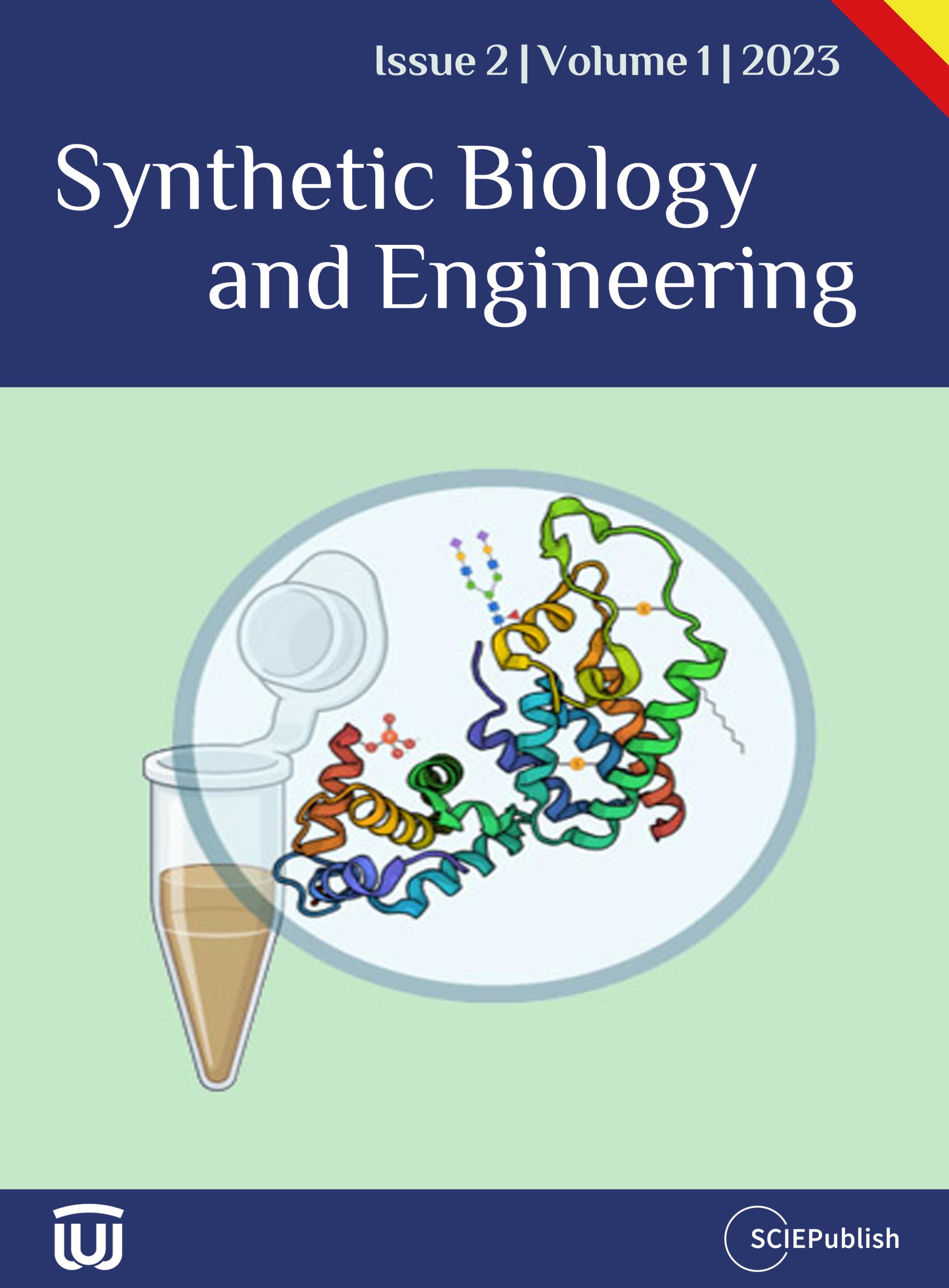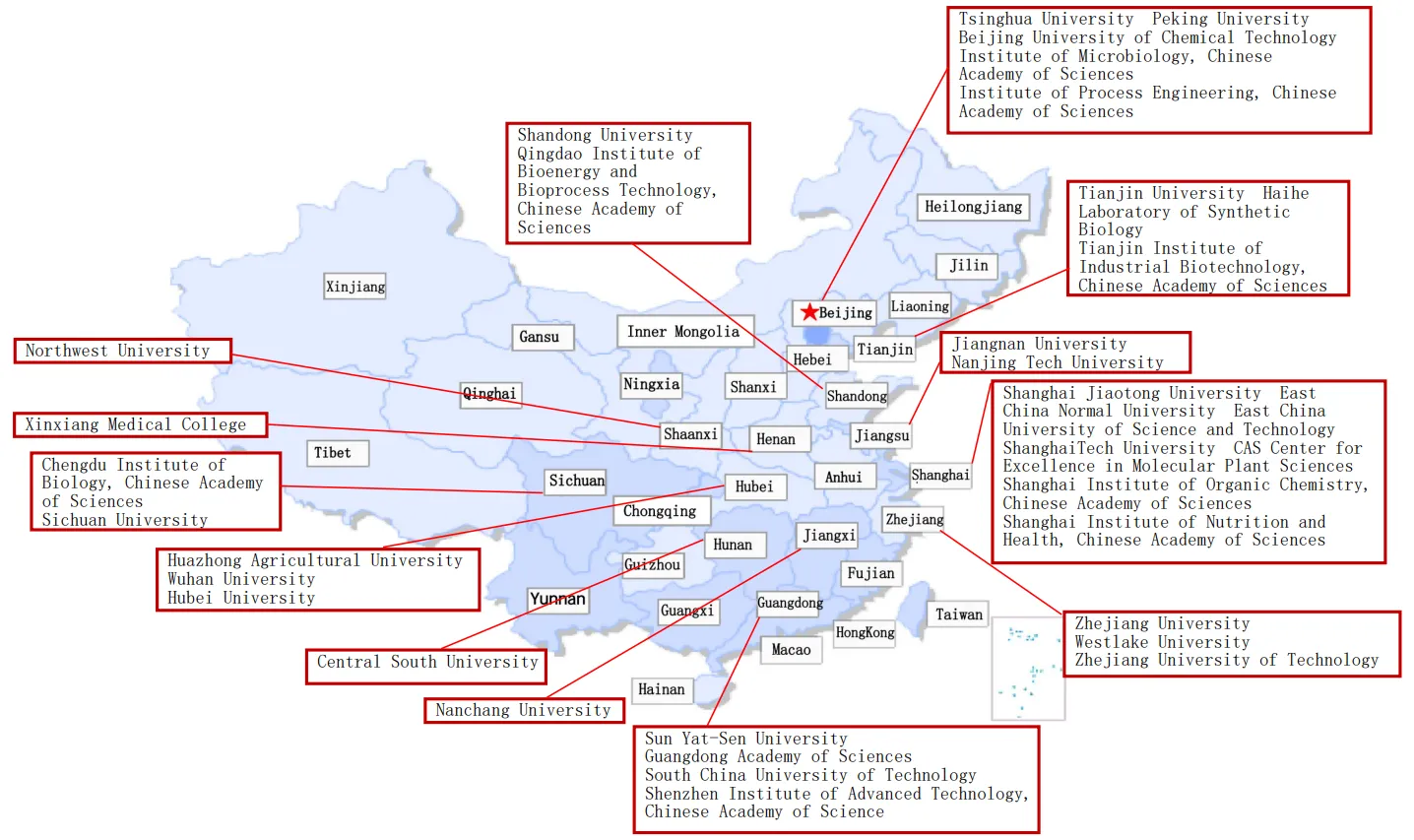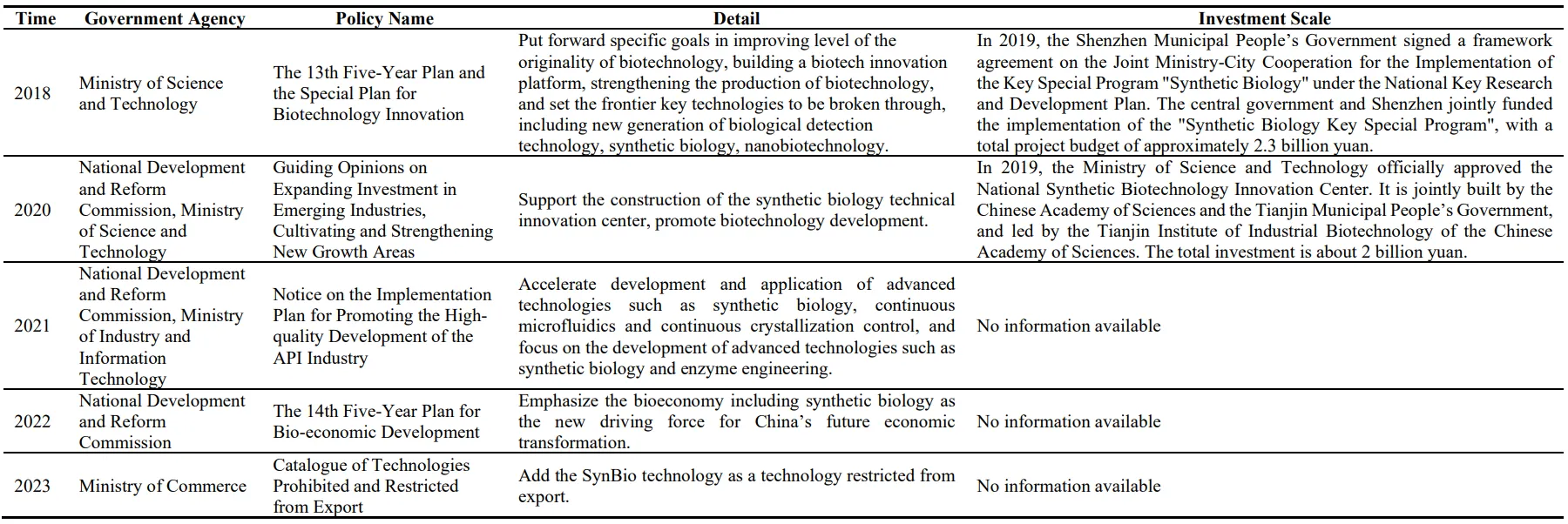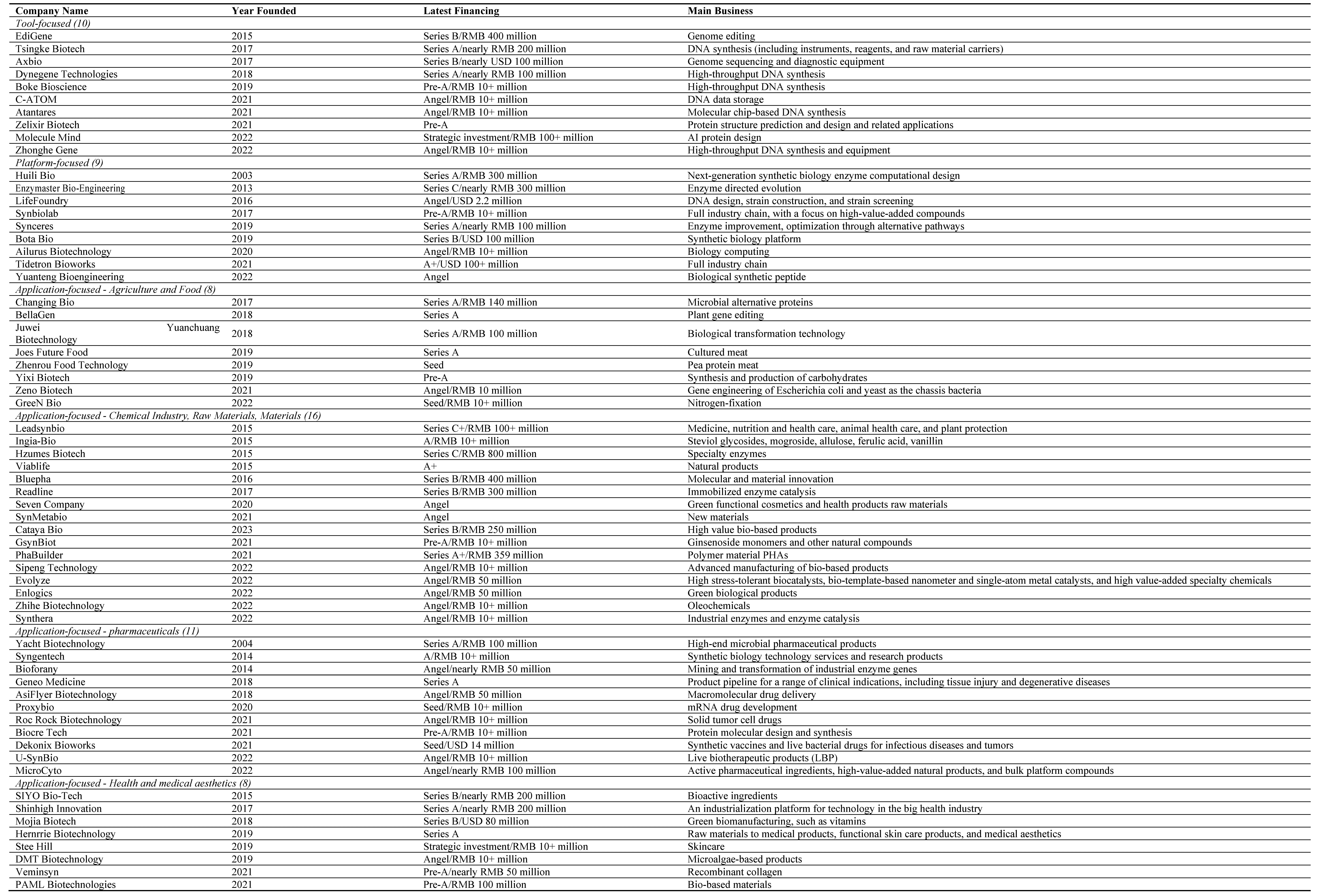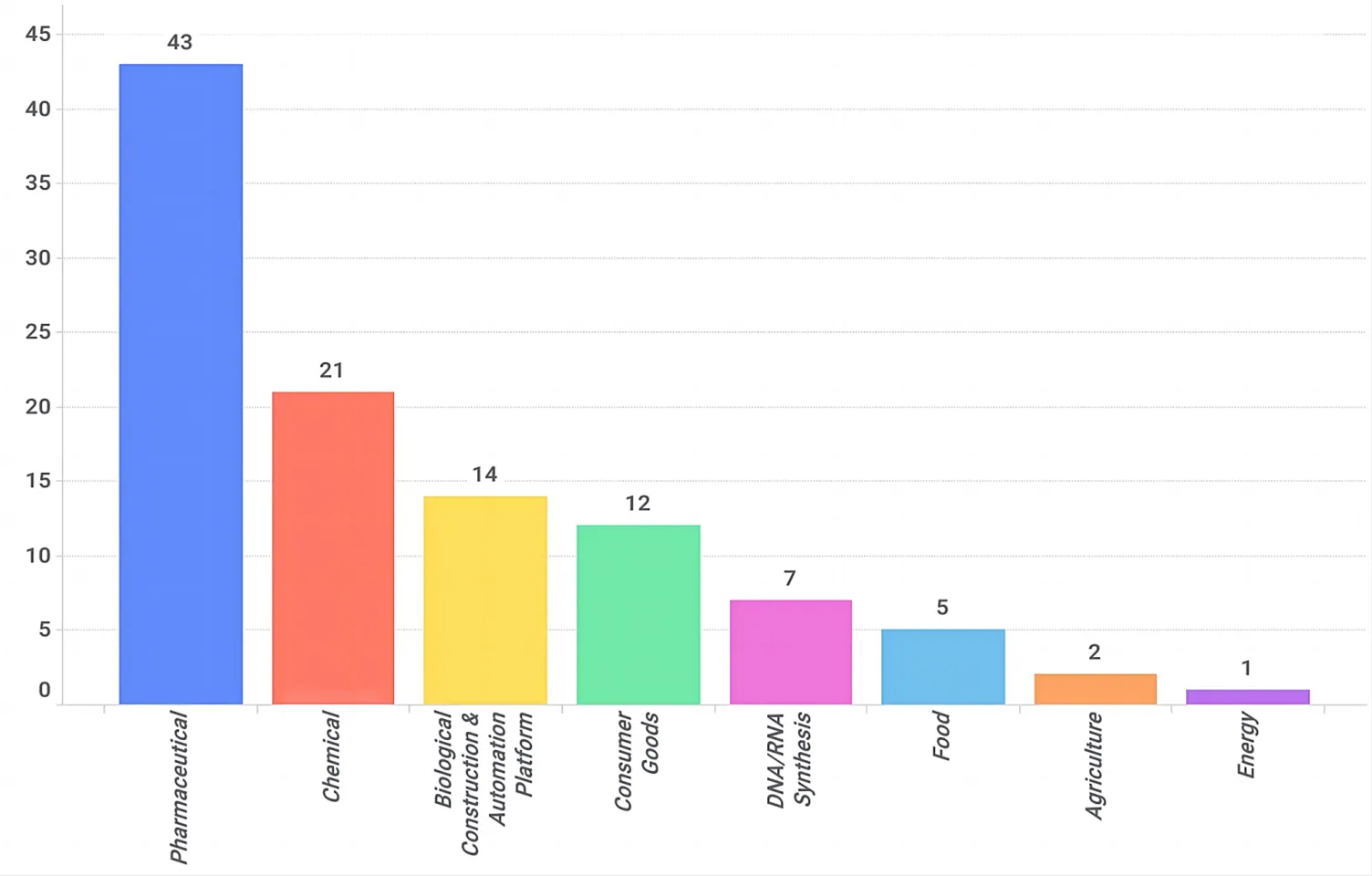Download PDF
Cite This Article
Contents
1. Introduction
2. State of SynBio Research and Technology in China
3. Main Applications of SynBio
4. SynBio Companies and Major Players in China
5. Prospects of SynBio industry in China
Acknowledgements
Author Contributions
Ethics Statement
Informed Consent Statement
Funding
Declaration of Competing Interest
References
Synthetic Biology Industry in China: Current State and Future Prospects
Author Information
Other Information
1
Shenzhen Institute of Advanced Technology, 1068 Xueyuan Avenue, Shenzhen University Town, Shenzhen 518055, China
2
Cataya Bio (Shanghai) Co., Ltd., 88 Daerwen Road, 4F/Building 2, Pudong New District, Shanghai 201203, China
3
Shenzhen Industrial Innovation Center for Engineering Biology, Xinhu Street, Guangming District, Shenzhen 518107, China
*
Authors to whom correspondence should be addressed.
Received: 31 July 2023 Revised: 08 September 2023 Accepted: 12 September 2023 Published: 14 September 2023
© 2023 The authors. This is an open access article under the Creative Commons Attribution 4.0 International License (https://creativecommons.org/licenses/by/4.0/).
Synth. Biol. Eng.
2023,
1(2), 10014;
DOI: 10.35534/sbe.2023.10014
ABSTRACT:
In this article, we provided an overview of the current state of the SynBio industry in China with a focus on its research and technology, its main applications, and major players. We also discussed future prospects including the challenges and advantages of the SynBio industry in China.
Keywords:
Synthetic biology industry; China
1. Introduction
Synthetic Biology (SynBio) is a relatively new field emerged in the early 2000s. There already exist many similar definitions on SynBio but from slightly different perspectives [1,2,3,4,5]. Wikipedia defines SynBio as a new area of biological research that combines science and engineering to design and build (“synthesize”) novel biological functions and systems [1]. Another definition states SynBio is the design and construction of new biological parts, devices, and systems, and the redesign of existing, natural biological systems for useful purposes [2]. According to [6], the element that distinguishes SynBio from traditional molecular and cellular biology is the focus on the design and construction of core components (parts of enzymes, genetic circuits, metabolic pathways, etc.) that can be modeled, understood, and tuned to meet specific performance criteria, and the assembly of these smaller parts and devices into larger integrated systems that solve specific problems. Here we prefer to interpret SynBio from the industrial point of view. Unlike traditional fermentation that relies on artisanal strain engineering, SynBio is a multi-disciplinary domain that integrates biology, engineering and software. Combining automation, high-throughput testing, big data and artificial intelligence, it transforms how biology is engineered and leads to higher efficiency for product research and development. For example, Amyris Inc. built an automated strain engineering platform in 2010, and by 2020, was able to achieve a 5-fold increase in R&D efficiency, an 80% reduction in average time, and 90% lower in average cost for its product development [7].
SynBio is still at an early stage of development globally. The U.S. is widely regarded as the leader in SynBio R&D, with a vibrant ecosystem of academic institutions, research organizations, start-ups, and investors. The U.S. has world renowned SynBio research teams such as the Jay Keasling group at the University of California, Berkeley, and the George Church group at Harvard University. The iGEM originated by MIT has attracted over 75,000 participants since its inaugural competition in 2003. The U.S. has also produced some of the most successful and influential SynBio companies in the world, such as Amyris, Ginkgo Bioworks, Zymergen, Perfect Day, Twist Bioscience, and Impossible Foods. These companies are applying SynBio to various domains including agriculture, biofuels, chemicals, food, and pharmaceuticals. According to a recent paper [8] published by Amyris, they used an automated R&D platform to engineer yeast and produced 454 biochemically diverse molecules within 4 years, an unprecedented achievement in biomanufacturing R&D. The U.S. also has a strong regulatory framework and public support for SynBio development, as well as a pro-bioeconomy policy agenda by the Biden administration that aims to advance American biotechnology and bio-manufacturing. A recently issued Executive Order, “Bold Goals for U.S. Biotechnology and Biomanufacturing” [9], outlined specific goals and steps to strength its competitiveness in a future bioeconomy with an estimated value between $4 trillion and $30 trillion USD globally [10]. This is another reflection of the U.S.’ strong ambition in synthetic biology.
In comparison to the U.S., China is still lagging overall in its SynBio R&D, especially in foundational technologies and tools, integrated platforms, and sophisticated strain development. For instance, over 96% patented strains were issued by the American institutions and companies between 1998 and 2018 globally [11]. However, China is not far behind in terms of SynBio capabilities and ambitions. China has a large pool of talent and abundant resources for SynBio research and development, as well as a large domestic market and robust demand for bio-based products and services. China also has a strategic vision and plan for SynBio development, as part of its broader goals to achieve scientific and technological self-reliance and to address environmental and social challenges. In this article, we provided an overview of the current state of the SynBio industry in China with a focus on its research and technology, its main applications, and major players. We also discussed future prospects, including the challenges and the advantages, of the SynBio industry in China.
2. State of SynBio Research and Technology in China
In recent years, China has made bioeconomy a national priority. As a result, SynBio research and its industrialization has become a major focus in its future development plan. Supported by the central and local governments, China has established several centers of excellence for SynBio research and launched several initiatives and platforms such as the China National GeneBank (CNGB), and the China National Center for Bioinformation (CNCB) to foster collaboration and innovation in SynBio. SynBio research has also enjoyed strong policy support from the government. To date, China has made notable progress in developing gene editing technologies, synthetic organisms, and bio-based manufacturing processes.
2.1. Basic Research in SynBio
At the basic research level, China has established a number of SynBio research centers in universities and academic institutions, including the Shenzhen Institute of Advanced Technology (SIAT), the Tianjin Institute of Industrial Biotechnology, Peking University, Zhejiang University, Shanghai Jiaotong University, Westlake University and Jiangnan University (Figure 1). These centers, such as the Institute of Synthetic Biology at the Shenzhen Institute of Advanced Technology and International Joint Research Center of SynBio at Tianjing University, are leading the basic research in bioinformatics, genomics, and metabolic engineering. The past year has seen many synthetic biology research achievements from China published in preeminent international journals. As an example, SIAT published 277 SynBio research papers in 2022, including 28 articles in the Cell/Nature/Science series, and 110 new patent applications. These scientific research achievements demonstrate China’s increasing strength in raising the level of basic research in SynBio. It is also worth noting that, recent returnees from abroad have also played an important role to raise the basic research level in China. One such notable example is Dr. Anping Zeng, a renowned scientist in the SynBio field and Member of the German National Academy of Science and Engineering, who joined Westlake University as the founding Director of the Westlake Center of Synthetic Biology and Integrated Bioengineering.
In the realm of foundational technologies, China is rapidly catching up and showing great potential, owing in large part to a growing cohort of exceptional representatives and achievements in DNA assembly [12,13,14], DNA sequencing [15], DNA synthesis [16,17], gene editing [18,19,20]. According to BCC Research, the global market for DNA reading, writing, and editing applications will grow from USD 17 billion in 2019 to USD 43.1 billion by 2024 [21]. China is emerging as an indispensable player in this niche market with its remarkable progress.
2.2. Bio-manufacturing Industry
In addition to its basic research, China has the world’s leading infrastructure in bio-manufacturing and capabilities to scale up production rapidly and cost-effectively, thereby laying a strong foundation for industrializing SynBio technology. China’s annual output of fermentation products exceeds 30 million tons, ranking first globally while accounting for about 70% of the global fermentation capacity. China also leads the world in the production of bulk bio-based products, such as amino acids, organic acids, and vitamins [22] (see Table 1 for its top fermentation companies based on bio-based product revenues). In addition, China has built incubators and dedicated SynBio facilities to enable the commercialization of research and technology. One notable facility is the Shenzhen Industrial Innovation Center for Engineering Biology (“Innovation Center”). The Innovation Center combines the resources from the local government in Shenzhen and the SIAT to establish China’s first “upstairs and downstairs” innovation and entrepreneurship complex. Here, “upstairs” researchers engage in original scientific innovation to solve fundamental challenges and support core technological advancements, while “downstairs” provides a platform for industrial incubation, supporting SynBio start-ups with shared laboratory equipment and other resources. This innovative model effectively bridges basic research and industrialization, establishing an enterprise incubation model across the entire chain of scientific research, technology translation, and commercialization.2.3. Policy Support for SynBio
SynBio research has been listed in National High-tech R&D Program of China (Program 863) in 2006 and National Basic Research Program of China (Program 973) since 2010. Policy support accelerates since China’s 13th Five-Year Plan (See Table. 2). For example, the Ministry of Science and Technology initiated a national key R&D program on “synthetic biology” in 2018; in 2020, the government issued Guiding Opinions on Expanding Investment in Strategic Emerging Industries and Cultivating Strengthened New Growth Points and Growth Poles, which supports various regulations, including the establishment of centers for SynBio technology innovation; in 2022, the National Development and Reform Commission released the 14th Five-Year Plan for Bio-economy Development, targeting cutting-edge areas such as synthetic biology, and implementing major national scientific and technological projects and key R&D programs; in 2023, the Ministry of Commerce, together with the Ministry of Science and Technology and other agencies, revised the Catalogue of Technologies Prohibited and Restricted from Export, by adding “synthetic biology technology” as a technology restricted from export. In addition to the national-level initiatives, various provinces and cities throughout China have also introduced synthetic biology-related policies, establishing the planning and support for the growth of this promising industry in the future.
2.4. Private Investment in SynBio
China’s synthetic biology industry has received enormous attention from various investment including the venture capital. Since 2018, financing by the domestic primary market for synthetic biology has been rising year over year, reaching a peak in 2021 in terms of the number of financing events as well as the total investment amount. The market for SynBio remained hot in the first half of 2022 but was slightly cooled in the second half. Despite the overall slowdown in investment by the primary market, private investment in SynBio continued to grow. From 2018 through 2022, the primary market of synthetic biology in China has witnessed 1039 investment and financing events (excluding IPOs, non-IPO listings, secondary listings, mergers and acquisitions, and private placements), involving 456 synthetic biology-related companies. The disclosed total funding exceeded RMB 92 billion [22], with investment hotspots concentrated in the areas of cell and gene therapy, DNA sequencing, automation and high-throughput laboratory equipment, and chemicals. This article compiled statistics on 62 domestic synthetic biology startups, with the summary of results illustrated in Table 3.
Figure 1. Distribution of representative SynBio researcsh institutions in China, compiled based on publicly available data (Credit: Shenzhen Industrial Innovation Center for Engineering Biology).
Table 1. China’s top fermentation enterprises (compiled based on publicly available data).
Table 2. Major policy support since China’s 13th Five Year Plan (2018–2023).
Table 3. Statistics of classified domestic startups in SynBio, compiled based on publicly available data (Credit: Shenzhen Industrial Innovation Center for Engineering Biology).
3. Main Applications of SynBio
Research and Markets predicts that the SynBio industry in China is expected to reach a market size of USD 2.9 billion by 2026, with a compounded annual growth rate of 32.4% from 2021 to 2026 [23]. The combination of macro policies, scientific research, and technological advancements has enabled the Chinese SynBio industry to thrive in a variety of fields Including agriculture, chemical and energy, food and nutrition, and healthcare.
3.1. Agriculture
SynBio can help increase agricultural productivity, improve crop quality, and reduce production costs, achieving sustainable development. The applications of synthetic biology in agriculture mainly involve crop yield improvement, pest control, animal feed, crop quality improvement, etc. For example, microbial or metabolic engineering techniques can be used to reduce the use of agricultural fertilizers and reshape metabolic pathways to improve crop quality. Guta Biotechnology has performed multi-gene editing on the key steps of the DHA metabolic pathway in Schizochytrium sp., leading to high-level accumulation of lipids. Source Species Biotech has used gene editing technology to breed peanuts with high oleic acid content.
3.2. Chemicals and Energy
SynBio holds enormous potential in helping the chemical and energy industry to transition away from petroleum-based manufacturing and building a new sustainable path for green industrialization [24]. The main applications of SynBio in the chemical industry include materials and chemicals, industrial enzymes, and biofuels. For example, modified yeast and other microorganisms can be used to produce chemicals, materials, and oils, and high-activity enzymes can be created through directed evolution combined with high-throughput screening. BBCA Group, a leading industrial biotech company in China that manufactures bio-based lactic acid, citric acid and amino acids, recently completed its PLA (polylactic acid) plant with a 100k MT capacity. Bluepha, a rising SynBio startup, has raised approximately $300M to develop strains and processes to produce fully bio-based, biodegradable materials known as PHAs (polyhydroxy alkanoates).
3.3. Food and Nutrition
SynBio technology can help explore the key genetic elements for the synthesis of nutrients and functional components in animals and plants, disrupting the existing methods of food production and processing. The applications of SynBio in food and nutrition mainly include meat and dairy products, beverages, food ingredients and additives, among others [25]. For example, based on traditional food manufacturing technology, synthetic biology can be used to modify synthetic pathways, optimize and coordinate protein expression, construct new cell factories, and produce various types of food. Shanghai-based CellX has developed serum-free culture media and used protein recombinant technology to develop purine-free beer.
3.4. Healthcare
Breakthroughs in enabling technologies such as DNA sequencing and DNA synthesis, and gene editing have opened up an accelerated development window for SynBio, bringing about disruptive innovations in traditional pharmaceutical manufacturing that could lead the future of the industry. The primary applications of SynBio in healthcare include cell immunotherapy, RNA drugs, microbiota therapy, gene editing-related applications, in vitro diagnostics, medical consumables, and pharmaceutical ingredient production of both small molecules and proteins. For example, mRNA technology can be used to rapidly create vaccines, while gene editing can be employed to treat genetic diseases, design cell behavior and phenotype to precisely modulate immune cells for tumor treatment, develop rapid and sensitive diagnostic agents, transform microorganisms for the production of medical consumables and pharmaceutical ingredients, and generate artificial phages for disease treatment. Legend Biotech has developed China’s first cell therapy drug and received FDA approval for marketing it in the U.S. Xbiome, a Shenzhen-based SynBio startup, has developed XBI-302, a fecal microbiota transplant drug candidate that has recently obtained FDA IND approval for clinical trials.
4. SynBio Companies and Major Players in China
Chinese companies in the SynBio industry can be broadly categorized into tool, platform, or product-focused. According to incomplete statistics from Bestla [22], there were 925 SynBio-related companies in China. These include 441 tool companies (47.6%), 54 platform companies (5.8%), and 430 product companies (46.4%). The tool companies engage in upstream work, specializing in providing DNA/RNA synthesis, sequencing, and genomics, as well as data-related SynBio foundational technologies, products, and services. The platform companies focus on strain construction, accumulating data through extensive experimentation, and offering technical platforms for the design and development of biological systems and organisms. The product companies seek to commercialize products, offering development and practical applications which are used in a variety of domains encompassing human life, including agriculture, food, energy, chemical industry, medical and cosmetic fields.
From a geographical perspective, the most representative synthetic biology companies in China are mainly located in five regions—Beijing, Shanghai, Jiangsu, Zhejiang, and Guangdong. The industrial development in the Yangtze River Delta region and the Guangdong-Hong Kong-Macao Greater Bay Area exhibits robust momentum and tremendous potential for growth. This article conducted a statistical analysis of 105 representative SynBio companies in China, classified them into eight major sectors based on their primary business focus and counted the number of representative companies in each sector (Figure 2). These eight sectors include agriculture, biological construction & automation platform, chemical, consumer goods, DNA/RNA synthesis, energy, food, and pharmaceutical. The number of companies in pharmaceutical, chemical, and biological construction & automation platform ranked in the top three. From a lens of regional representative enterprises, Beijing, Shanghai, and Jiangsu Province have a major share of companies in the pharmaceutical sector, while Zhejiang has a predominant presence in the pharmaceutical and chemical sectors. Companies from Guangdong focus primarily on consumer goods and biological construction & automation platforms. This presents the aggregative effect of regional development and the differentiation of competition across regions.
A number of SynBio companies have emerged as leaders in various markets in China. In biomaterials, Cathay Industrial Biotech has been a primary supplier of fermentation-derived long-chain dicarboxylic acids and is developing a biomanufacturing process to produce pentamethylene diamine, breaking into the bio-based polyamides market. Anhui Huaheng Biotechnology has unleashed its production capacity for L-alanine and L-valine, establishing itself as an important player in amino acids. In personal care, Bloomage Biotechnology, the leading supplier of hyaluronic acid, has been building its SynBio research capabilities in an effort to broaden its cosmetic ingredient as well as consumer product pipelines. In food and agriculture, Biosysen has utilized software engineering concepts to guide species design, launching a line of craft beers designed based on bacterial strains, which have been highly acclaimed by the market.
Figure 2. Distribution of representative SynBio companies in China by sector, compiled based on publicly available data (Credit: Shenzhen Industrial Innovation Center for Engineering Biology).
5. Prospects of SynBio industry in China
According to a report by McKinsey, over 60% of products in the global economy can be produced using biotechnology, and nearly 400 application scenarios are expected to generate a direct economic impact of up to USD 4 trillion over the next 10–20 years [26]. Synthetic biology is regarded as a critical industry for the future and has become a subject of competition among nations. As far as China is concerned, the prospects for the synthetic biology industry are promising if it can overcome some of its challenges while strengthen its many advantages.
5.1. Challenges Faced by the Chinese SynBio Industry
The SynBio industry has experienced a period of rapid expansion since 2010, with both traditional chemical companies and emerging enterprises actively developing layouts in this exciting field [27]. The development of synthetic biology technology relies on basic research, while the commercialization of scientific research findings requires a well-established industrial model and supportive government policies. In recent years, China has accelerated its efforts in basic research, industrial development, and policy support for SynBio, propelling the entire industry into a fast lane of growth with enormous developmental opportunities, but not without challenges.
From a technological perspective, China currently faces challenges in two areas: technological innovation and technological barriers. In terms of technological innovation, China has yet to overcome the issue of affordable long-chain DNA synthesis, with the cost being still too high and the turnaround time being too long for routine use in R&D. Furthermore, for the modification of high-yield strains that are difficult to genetically manipulate, the current metabolic pathway predictions and model designs require improvement to establish more generally applicable and efficient technologies. The constraints of technological barriers mainly lie in intellectual property rights and advanced R&D equipment. China is significantly lagging in the intellectual property rights for some core technologies, such as the creation of biocatalysts, core strains, and key enzymes, which are still controlled by other countries including the U.S. As for R&D equipment, China lacks a system centered around microbial reactors, process sensing and detection, and biotechnology software engineering based on technologies such as big data and artificial intelligence. Critical components of fermentation equipment, such as stirring probes, sensors, and temperature regulators, have long been monopolized by imported equipment companies. To achieve its ambition of becoming a global leader in the SynBio industry, China must create its own technological advantages and break foreign technological monopolies.
In industrializing SynBio technology and creating an innovative industrial ecosystem, there also exist significant challenges, mainly in the following three aspects that require government policy to help address:
(1) Fostering a favorable environment for intellectual property protection. The risk of loss or theft of research results, such as synthetic biology strains, is high, especially in the booming industry, where a rapid and coordinated system for protecting intellectual property is crucial to promote a benign competition structure within the industry.
(2) Building a relatively flexible regulatory system. In fields such as food and beverage, healthcare, agriculture, forestry and animal husbandry, chemical industry, and energy, product safety and quality are paramount. China’s biosafety regulatory system still needs improvement. For cutting-edge technologies such as gene editing, microbial therapy, and genetically modified organisms, application standards, and norms should be clearly and promptly defined. For policy tools, flexibility, coordination, and support functions should be strengthened. Pilot windows should be actively promoted, allowing innovation to be first tested on a small scale. Equally important is to accelerate the examination, approval, and market access of innovative biotech products by simplifying the regulatory process.
(3) Establishing sustained support of preferential policies. As a cutting-edge innovative technology, synthetic biology has high R&D costs and trial-and-error costs. The period from basic research to industrialization is typically long. It is therefore essential for the government to create necessary policies to support project incubation and drive the overall innovation of the industry forward.
5.2. Advantages of the Chinese SynBio Industry
China’s SynBio industry and market differentiates itself from rest of the world in a few main aspects. Firstly, China has a significant cost advantage in upstream R&D and even more so in downstream process and scale up manufacturing owing to cheaper labor cost and more complete infrastructure. Secondly, China’s vast population and extensive resources offer unique advantages to its SynBio industry. The country’s large market size creates opportunities for testing, manufacturing, and commercializing synthetic biology products. China’s abundant biological resources, including diverse ecosystems and genetic diversity, contribute to a rich pool of genetic material for bioengineering. Thirdly, China has a large and highly skilled workforce, including scientists and engineers with expertise in SynBio. China also actively engages in international collaborations and investments with global companies, research institutions, and startups to share knowledge, technologies, and market access to foster the growth of its SynBio industry. Fourthly, SynBio is in line with China’s ambitions to reach the peak of carbon emission by 2030 and achieve carbon neutrality by 2060, as stated by President Xi at the General Debate of the 75th Session of The United Nations General Assembly in 2020. This creates a golden opportunity for the whole SynBio sector since it is deemed as the silver bullet to tackle the issue of carbon emission and transition away from fossil fuel-based manufacturing.
As China continues to advance its basic research and develop foundational technologies in SynBio, strengthen its lead in industrializing SynBio, in particular, by upgrading its industrial research and development capabilities while leveraging its dominant advantages in biomanufacturing infrastructure and a low-cost skilled workforce, it will be able to maintain a long-term competitiveness in SynBio industry. With the support of sound policy environments, the SynBio industry China is expected to enter a critical phase of breakthroughs and sustained growth in the coming years.
Acknowledgements
We thank Dr. Yuliang Huang for his support and comments, and Dr. Liuyang Diao for his suggestions in writing this manuscript.
Author Contributions
Conceptualization, L.Z. and W.L.; Writing—Original Draft Preparation, W.L., Y.Z., J.P. and L.Z.; Writing—Review & Editing, W.L., Y.Z., J.P. and L.Z.
Ethics Statement
Not applicable.
Informed Consent Statement
Not applicable.
Funding
This research received no external funding.
Declaration of Competing Interest
The authors declare that they have no known competing financial interests or personal relationships that could have appeared to influence the work reported in this paper.
References
1.
Wikipedia. Synthetic Biology. Available online: https://en.wikipedia.org/wiki/Synthetic_biology (accessed on 12 September 2023).
2.
Roberts MAJ, Cranenburgh RM, Stevens MP, Oyston PCF. Synthetic biology: biology by design. Microbiology 2013, 159, 1219. [Google Scholar]
3.
Benner SA, Sismour AM. Synthetic biology. Nat. Rev. Genet. 2005, 6, 533–543. [Google Scholar]
4.
Khalil AS, Collins JJ. Synthetic biology: applications come of age. Nat. Rev. Genet. 2010, 11, 367–379. [Google Scholar]
5.
Heinemann M, Panke S. Synthetic biology—putting engineering into biology. Bioinformatics 2006, 22, 2790–2799. [Google Scholar]
6.
Zhao H. Synthetic Biology: Tools and Applications; Academic Press: Cambridge, MA, USA, 2013.
7.
Amyris Investor Mini-Series 1. Available online: https://investors.amyris.com/2020-12-03-Amyris-Launches-Virtual-Investor-Mini-Series (accessed on 12 September 2023).
8.
Singh, AH, Kaufmann-Malaga BB, Lerman JA, Dougherty DP, Zhang Y, Kilbo AL, et al. An Automated Scientist to Design and Optimize Microbial Strains for the Industrial Production of Small Molecules. bioRxiv 2023, doi:10.1101/2023.01.03.521657.
9.
The White House Office of Science and Technology Policy. Bold Goals for U.S. Biotechnology and Biomanufacturing. 2023. Available online: https://www.whitehouse.gov/wp-content/uploads/2023/03/Bold-Goals-for-U.S.-Biotechnology-and-Biomanufacturing-Harnessing-Research-and-Development-To-Further-Societal-Goals-FINAL.pdf (accessed on 12 September 2023).
10.
Synthetic Biology Is About to Disrupt Your Industry. Available online: https://www.bcg.com/publications/2022/synthetic-biology-is-about-to-disrupt-your-industry (accessed on 12 September 2023).
11.
Liu L, Wu L, Ma J, Wu X. Analysis of the deposits and samples of global patent microorganisms in the past 20 years. Acta Microbiol. Sin. 2021, 61, 3836–3843. [Google Scholar]
12.
Li SY, Zhao GP, Wang J. C-Brick: a new standard for assembly of biological parts using Cpf1. ACS Synth. Biol. 2016, 5, 1383–1388. [Google Scholar]
13.
Zhou J, Wu R, Xue X, Qin Z. CasHRA (Cas 9-facilitated Homologous Recombination Assembly) method of constructing megabase-sized DNA. Nucleic Acids Res. 2016, 44, e124. [Google Scholar]
14.
Jiang W, Zhao X, Gabrieli T, Lou C, Ebenstein Y, Zhu TF. Cas9-Assisted Targeting of Chromosome segments CATCH enables one-step targeted cloning of large gene clusters. Nat. Comm. 2015, 6, 8101. [Google Scholar]
15.
Anslan S, Mikryukov V, Armolaitis K, Ankuda J, Lazdina D, Makovskis K, et al. Highly comparable metabarcoding results from MGI-Tech and Illumina sequencing platforms. PeerJ 2021, 9, e12254. [Google Scholar]
16.
Synthetic Biology & Bio Design. Available online: https://synbio-tech.com/synthetic-biology/ (accessed on 12 September 2023).
17.
QuarXeq by Dynegene. Available online: https://www.dynegene.com/index.php?c=article&id=315 (accessed on 12 September 2023).
18.
Liu Y, Cao Z, Wang Y, Guo Y, Xu P, Yuan P, et al. Genome-wide screening for functional long noncoding RNAs in human cells by Cas9 targeting of splice sites. Nat. Biotech. 2018, 36, 1203–1210. [Google Scholar]
19.
Hu Y, Zu C, Zhang M, Wei G, Li W, Fu S, et al. Safety and efficacy of CRISPR-based non-viral PD1 locus specifically integrated anti-CD19 CAR-T cells in patients with relapsed or refractory Non-Hodgkin’s lymphoma: a first-in-human phase I study. Blood 2022, 144, 7491–7429. [Google Scholar]
20.
Li L, Liang Y, Kang L, Liu Y, Gao S, Chen S, et al. Transcriptional regulation of the Warburg effect in cancer by SIX1. Cancer Cell 2018, 33, 368–385. [Google Scholar]
21.
Global DNA read, write and edit market. Available online: https://www.bccresearch.com/market-research/biotechnology/dna-technologies-market-report.html (accessed on 12 September 2023).
22.
CYZONE Research Report on the Development of China’s Synthetic Biology Industry in 2022. Available online: https://www.cyzone.cn/article/714214.html (accessed on 12 September 2023).
23.
Global Synthetic Biology Market to Reach US$28.8 Billion by the Year 2026. Available online: https://www.globenewswire.com/news-release/2022/01/19/2369148/0/en/Global-Synthetic-Biology-Market-to-Reach-US-28-8-Billion-by-the-Year-2026.html (accessed on 12 September 2023).
24.
French KE. Harnessing synthetic biology for sustainable development. Nat. Sus. 2019, 2, 250–252. [Google Scholar]
25.
Shi S, Wang Z, Shen L, Xiao H. Synthetic biology: a new frontier in food production. Trends Biotech. 2022, 40, 781–803. [Google Scholar]
26.
The bio revolution: innovations transforming economies, societies, and our lives. Available online: https://www.mckinsey.com/industries/pharmaceuticals-and-medical-products/our-insights/the-bio-revolution-innovations-transforming-economies-societies-and-our-lives (accessed on 12 September 2023).
27.
Engineering Life: Funding to Synthetic Biology Startups Surpasses $1B. Available online: https://www.cbinsights.com/research/synthetic-biology-startup-funding/ (accessed on 12 September 2023).
